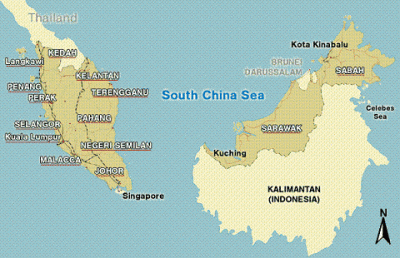 Alan (Dry, instructional component):
Alan (Dry, instructional component):
We have been in Kuching, the capital city of the Malaysian state of Sarawak, on the island of Borneo. [CORRECTED 9 Nov] In 1957, the Malay peninsula formed a federation made up of newly independent colonies. In 1963, Sarawak and Sabah (also former English colonies) joined Malaya, along with Singapore, to create the modern country of Malaysia. In 1965, Singapore left the federation to become an independent country. In 2007, Malaysia is gearing up for a huge celebration of the 50th anniversay of the creation of Malaysia – a good time to think about visiting (hint-senior niece, Janice & Colin, Debbie & Tom, and anyone else looking for a wonderful, EASY, and tasty trip).
Borneo (the island) has 3 countries. Malaysia (the other half is on the Thai peninsla), Indonesia (distributed over several islands), and Brunei (exclusively on Borneo).
I now return you to the way more interesting part of the blog.
Harriet:
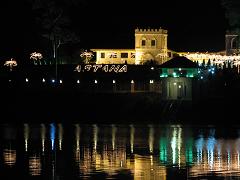
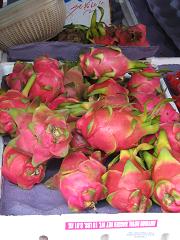
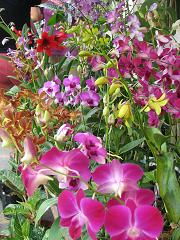
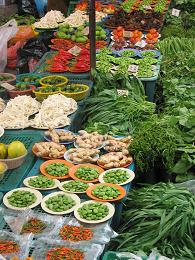
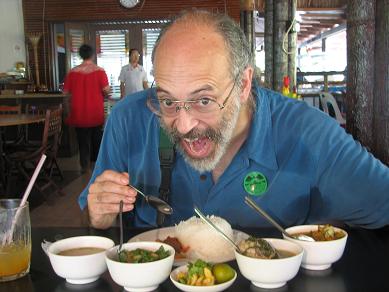 History… yes, yes, all very interesting. I’ll share a few other tidbits and those of you who would prefer a more in-depth study of the geo-political-historical aspects can write directly to Alan.
History… yes, yes, all very interesting. I’ll share a few other tidbits and those of you who would prefer a more in-depth study of the geo-political-historical aspects can write directly to Alan.
Kuching is a very pleasant, walkable city. There are a fair number of conferences happening and a number of Malay tourists are enjoying the town. There are very, very few “round eyes” and, with the exception of Nina (more on her later), we haven’t seen any Americans. The Brits and other northern Europeans are here escaping the cold, but primarily, we’re seeing Malays, some Japanese and Chinese.
We visited several spectacular museums and usually had them all to ourselves. (And they were all free.) We explored the open air markets bursting with fresh produce, meat, fish, plants, hardware, clothing and food stalls so we could keep up our shopping energy.
In addition to the traditional, “exotic” markets, Kuching is full of high-rise shopping malls selling EVERYTHING for stunningly low prices. (Anyone need a watch for $2?) The big U.S. chains are here. 7-11 is everywhere (Alan is very happy). KFC is everywhere. Burger King is around as are Pizza Hut, McDonald’s, Famous Amos, and my favorite, the Coffee Bean and Tea Leaf (yes, THAT CB&TL headquartered in Camarillo).
In the evenings, we usually stroll along the waterfront and eat fabulous, cheap food. Our breakfasts have been typically Malaysian and taken in one of the nearby food stalls. A basic breakfast is usually a noodle soup or fried noodles (wheat or rice, different widths) with any combination of meats, sprouts, veggies, egg. Malaysian Borneo has so many culinary influences, it’s difficult to have something purely Malay. Breakfast, including Alan’s morning cola, for the two of us averages about $2.50.
Our lunches and dinners have been truly “fusion” in nature –Thai, Chinese, Indian as well as Malay. And then there’s the snacking: waffles with chocolate or peanut butter, little cupcake-like things, steamed pork buns and other dim sum sorts of dumplings, roti (Indian crepe), baked peanut butter buns, lots of ice cream (Nestle’s drumsticks) spicy chicken puffs, fried bananas, little buttery English muffin sorts of things (see photo), satay everywhere, and, thankfully, Pepsi and Coca Cola for you know who.
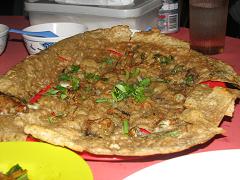
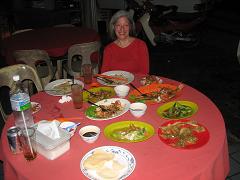
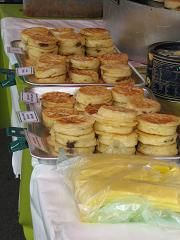
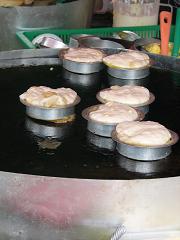 One night, we took ourselves to a large, open seafood restaurant next to the river. It took us awhile to figure out we needed to select our own fish and negotiate its preparation. We ordered snapper, prawns, an oyster pancake (see photo) and some vegetables. We didn’t have a clue as to the volume that would appear at our table. There was a family of at least a dozen people nearby. Evidently, we ordered enough food for them as well. (The photo shows Harriet with the remnants of our meal.)
One night, we took ourselves to a large, open seafood restaurant next to the river. It took us awhile to figure out we needed to select our own fish and negotiate its preparation. We ordered snapper, prawns, an oyster pancake (see photo) and some vegetables. We didn’t have a clue as to the volume that would appear at our table. There was a family of at least a dozen people nearby. Evidently, we ordered enough food for them as well. (The photo shows Harriet with the remnants of our meal.)
There was a basket of prawn crackers to snack on until the huge dishes started arriving. The fish was an entire, huge Red Snapper; the oyster pancake was easily 12″ across and stuffed with small oysters; the gigantic garlic prawns numbered more than a dozen; the spicy fried noodles had shrimp, calamari, beef, bbq pork and vegetables; then came the platters of baby bok choy and mixed vegetables. It was all good, but frankly, we were so overwhelmed by the volume we barely made a dent and felt like disgusting pigs.
The whole tab came to $21.
Our other stupidly expensive meal was a traditional “Steamboat” at the Crowne Plaza Hotel. It’s basically shabu-shabu. They schlep a propane tank to your table and hook it up to a combination soup pot and grill. Then you help yourself to the raw fish/meat/veggie buffet and cook your own meal at the table. It’s a fun idea and because we were hanging out with a new friend it was nice setting. But really, did we fly half way around to globe to cook our own food? I think not.
Total tab for the 3 of us: $37 (including tax and drinks). Outrageous expense.
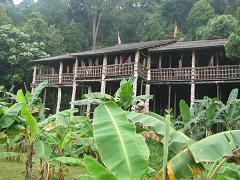
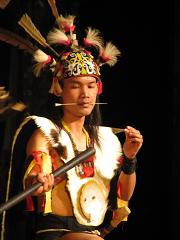
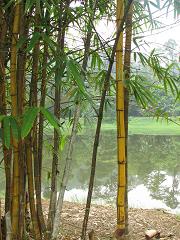
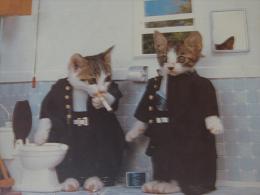
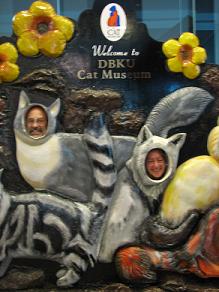 Between meals, we took a day trip to the Sarawak Cultural Center. It’s a sort of Disney-like approach to learning about the different tribes and cultures of Borneo, but the setting is spectacular and it was really quite interesting. Between our visits to the different tribal houses, we enjoyed the staged show of music and dancing. Ornate costumes, graceful dances, native music (gamelan, drumming, some string music) and a blowpipe dance/demonstration where the dancer blew darts 50 feet or so, over the crowd, to pop balloons.
Between meals, we took a day trip to the Sarawak Cultural Center. It’s a sort of Disney-like approach to learning about the different tribes and cultures of Borneo, but the setting is spectacular and it was really quite interesting. Between our visits to the different tribal houses, we enjoyed the staged show of music and dancing. Ornate costumes, graceful dances, native music (gamelan, drumming, some string music) and a blowpipe dance/demonstration where the dancer blew darts 50 feet or so, over the crowd, to pop balloons.
At the end of the show, they invite the audience to come up and join in the dancing. So a couple dozen people (certainly not us) just hopped up on the stage and started gyrating around to the music. (Santa Barbararians might equate this to “Dance-Away” with a camera-toting audience.)
Our other outskirts-of-town outing was to see the famous Kuching Cat Museum. “Kuching” means cat in Bahasa Malaysia and there are several stories about how the city came to be so named. There are hokey cat statues all over the place. And then there are the awful souvenirs with cats…
 Anyway, we went to the museum because we thought it would be a mildly bizarre thing to do… and it was.
First off, it’s housed in an enormous mosque-like center that serves as North Kuching City Hall and it takes up half of the first floor. The guards didn’t look armed, but they were there to protect the museum as well as City offices.
The entrance was wonderfully tacky. The first exhibits were a combination of bad taxidermy (stuffed cats suitable for bad horror movie sets) and odd commercial collections of all things feline (keychains, mugs, painted rocks, purses, and a lovely photo opportunity). The subsequent exhibit halls were divided into cultural/historical references — the history of cats in different cultures (Egypt, Japan, China, etc.). Then came the rooms of cats in the movies (or movie titles), cats in porcelain, cats in paintings, cats in advertising, cats on plates, cats in cartoons, cats in poetry and literature, famous cat lovers (did you know that Sir Isaac Newton invented the cat door?), cat proverbs, cat food, cat fish (yes, an entire wall devoted to the very, very distant piscean cousin) — it just kept going.
Did I mention the huge glass case devoted to cat burglars?
Of course there was a room devoted to explaining EVERY fricken breed of domesticated cat and homage to the Malaysian organization that hosted the Cat World Cup or whatever the hell they called it.
There was a cat cave but the lights weren’t working, so we listened to various cat calls/growls/screeches coming from shadowy sculptures of, we presume, cats.
Admittedly, the whole thing was amazingly well done. And we feel that, as dog people, we have more than bent over backwards to show our respect, admiration and appreciation for our feline counterparts.
Next up:Â The Development MercenaryÂ
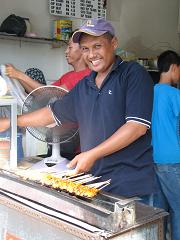
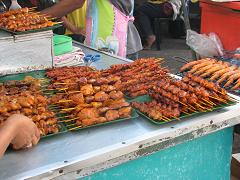
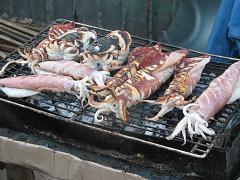
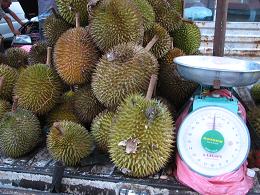
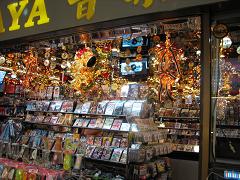
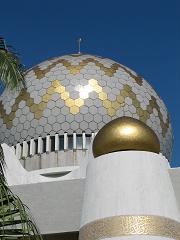
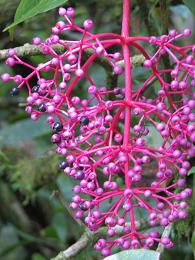
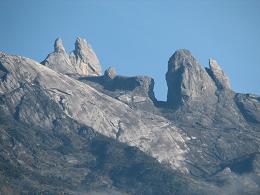

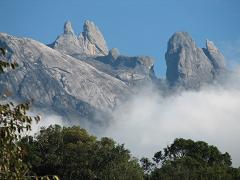 Part Satu (1): Kota Kinabalu
Part Satu (1): Kota Kinabalu Alan (Dry, instructional component):
Alan (Dry, instructional component):



 History… yes, yes, all very interesting. I’ll share a few other tidbits and those of you who would prefer a more in-depth study of the geo-political-historical aspects can write directly to Alan.
History… yes, yes, all very interesting. I’ll share a few other tidbits and those of you who would prefer a more in-depth study of the geo-political-historical aspects can write directly to Alan.


 One night, we took ourselves to a large, open seafood restaurant next to the river. It took us awhile to figure out we needed to select our own fish and negotiate its preparation. We ordered snapper, prawns, an oyster pancake (see photo) and some vegetables. We didn’t have a clue as to the volume that would appear at our table. There was a family of at least a dozen people nearby. Evidently, we ordered enough food for them as well. (The photo shows Harriet with the remnants of our meal.)
One night, we took ourselves to a large, open seafood restaurant next to the river. It took us awhile to figure out we needed to select our own fish and negotiate its preparation. We ordered snapper, prawns, an oyster pancake (see photo) and some vegetables. We didn’t have a clue as to the volume that would appear at our table. There was a family of at least a dozen people nearby. Evidently, we ordered enough food for them as well. (The photo shows Harriet with the remnants of our meal.)



 Between meals, we took a day trip to the Sarawak Cultural Center. It’s a sort of Disney-like approach to learning about the different tribes and cultures of Borneo, but the setting is spectacular and it was really quite interesting. Between our visits to the different tribal houses, we enjoyed the staged show of music and dancing. Ornate costumes, graceful dances, native music (gamelan, drumming, some string music) and a blowpipe dance/demonstration where the dancer blew darts 50 feet or so, over the crowd, to pop balloons.
Between meals, we took a day trip to the Sarawak Cultural Center. It’s a sort of Disney-like approach to learning about the different tribes and cultures of Borneo, but the setting is spectacular and it was really quite interesting. Between our visits to the different tribal houses, we enjoyed the staged show of music and dancing. Ornate costumes, graceful dances, native music (gamelan, drumming, some string music) and a blowpipe dance/demonstration where the dancer blew darts 50 feet or so, over the crowd, to pop balloons.